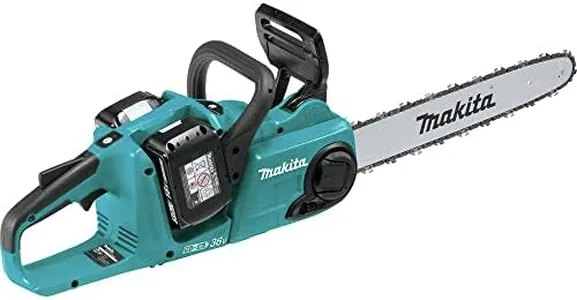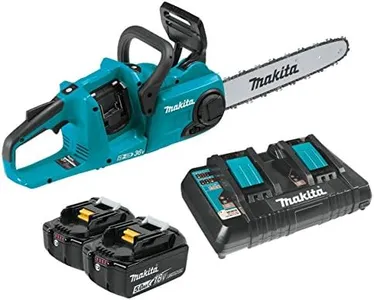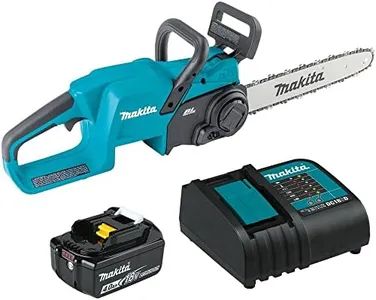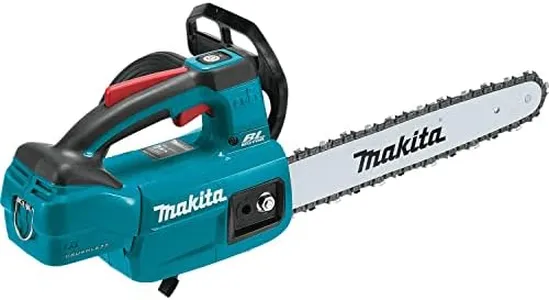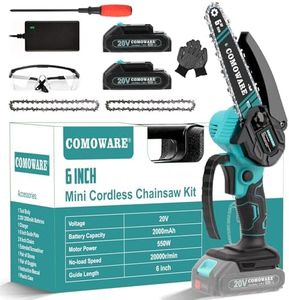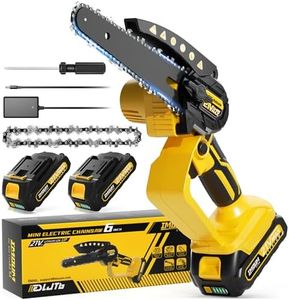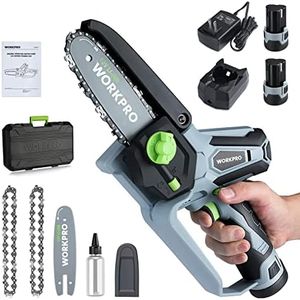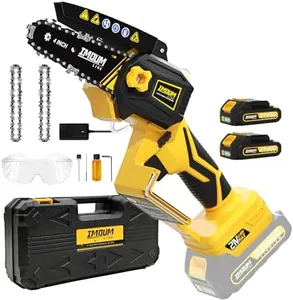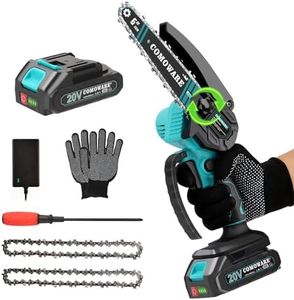5 Best Makita Chainsaws 2025 in the United States
Our technology thoroughly searches through the online shopping world, reviewing hundreds of sites. We then process and analyze this information, updating in real-time to bring you the latest top-rated products. This way, you always get the best and most current options available.

Our Top Picks
Winner
Makita XCU04PT LXT Lithium-Ion Brushless Cordless 16" Chain Saw Kit (5.0Ah)
Most important from
853 reviews
The Makita XCU04PT LXT Lithium-Ion Brushless Cordless 16" Chain Saw Kit is a solid option for those seeking a cordless chainsaw with good power and convenience. Its brushless motor provides high efficiency and performance comparable to a 32cc gas chainsaw, making it powerful enough for most cutting tasks. The 16-inch bar length is suitable for medium-sized jobs, providing a good balance between maneuverability and cutting capacity.
At 19.2 pounds, it's not the lightest chainsaw on the market, but it remains manageable for many users, especially considering it is cordless and comes with the convenience of lithium-ion batteries included in the kit. The variable speed trigger and high chain speed of 3,940 FPM enhance its cutting performance, making it easier to handle different types of wood and thicknesses. The tool-less chain adjustment feature is a big plus for ease of maintenance, allowing users to quickly and easily adjust the chain without needing extra tools.
Safety features are well thought out, with a built-in lock-off lever to prevent accidental engagement and an LED on/off switch with an auto power-off function to conserve battery life. However, the weight could be a downside for prolonged use, and some users may prefer a lighter option. Additionally, being a cordless model, its performance is tied to battery life, which may require frequent recharges during extended use. This chainsaw is best suited for homeowners and DIY enthusiasts looking for a reliable, cordless option for medium-duty tasks.
Most important from
853 reviews
Makita XCU06Z 18V LXT® Lithium-Ion Brushless Cordless 10" Top Handle Chain Saw, Tool Only
Most important from
703 reviews
The Makita XCU06Z is a compact, battery-powered chainsaw designed for light to medium-duty tasks such as pruning, trimming, and limbing. Its top handle design makes it easy to maneuver, especially for overhead work. Powered by an 18V LXT Lithium-Ion battery (which needs to be purchased separately), this chainsaw offers performance comparable to a 22cc gas chainsaw, making it a powerful choice for its size.
It features a brushless motor for efficient operation and a torque boost mode to help cut through denser materials. The 10-inch bar length is suitable for smaller jobs and more detailed work, while the chain speed of 4,720 feet per minute ensures quick and efficient cuts. Weighing in at 7.2 pounds, it is relatively lightweight, which helps reduce fatigue during extended use.
The captured bar nut and lateral chain tensioning make maintenance straightforward, which is a great benefit for those who prefer easy upkeep. This chainsaw is ideal for homeowners and gardeners looking for a reliable tool for light to medium pruning and trimming tasks.
Most important from
703 reviews
Makita XCU03PT 18V X2 (36V) LXT Lithium-Ion Brushless Cordless (5.0Ah) 14" Chain Saw Kit, Teal
Most important from
301 reviews
The Makita XCU03PT is a cordless chainsaw that stands out for its eco-friendly features and user-friendly design. With an 18V X2 (36V) power system, this saw mimics the performance of a traditional 32cc gas chainsaw while eliminating the need for gas, oil mixing, and pull starts. This makes it an excellent choice for those who want to avoid the hassle and emissions associated with gas-powered tools.
One of the notable strengths is its powerful Makita-built brushless motor, which provides strong cutting performance with a chain speed of 3,940 FPM. Additionally, the two 18V 5.0Ah lithium-ion batteries offer up to 190 cuts in 4x4 cedar, ensuring that users can tackle demanding tasks without frequent recharging.
The 14-inch bar length is suitable for smaller to medium-sized jobs, making it a good fit for homeowners or hobbyists who need a reliable saw for trimming and light tree work. The lightweight design at 16 pounds enhances maneuverability, allowing for easier handling compared to heavier gas chainsaws. A key feature is the tool-less chain adjustment, which simplifies maintenance and allows for quick adjustments on the go. The battery-powered aspect reduces maintenance needs, but users will need to keep an eye on battery life for larger jobs that may exceed the cutting capacity of the two included batteries.
Most important from
301 reviews
Buying Guide for the Best Makita Chainsaws
Choosing the right chainsaw can make a significant difference in your cutting tasks, whether you're a professional lumberjack or a homeowner looking to maintain your yard. When selecting a chainsaw, it's important to consider several key specifications to ensure you get a model that fits your needs. Understanding these specs will help you make an informed decision and get the best performance out of your chainsaw.FAQ
Most Popular Categories Right Now
